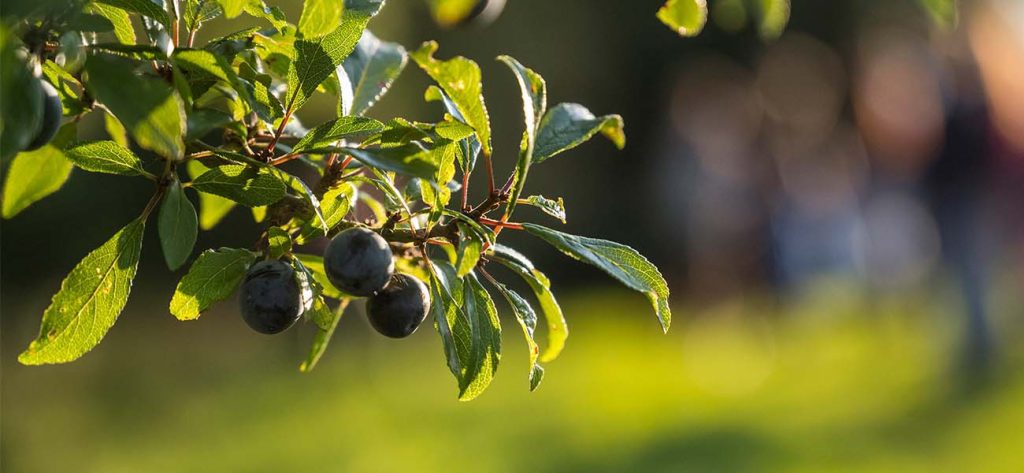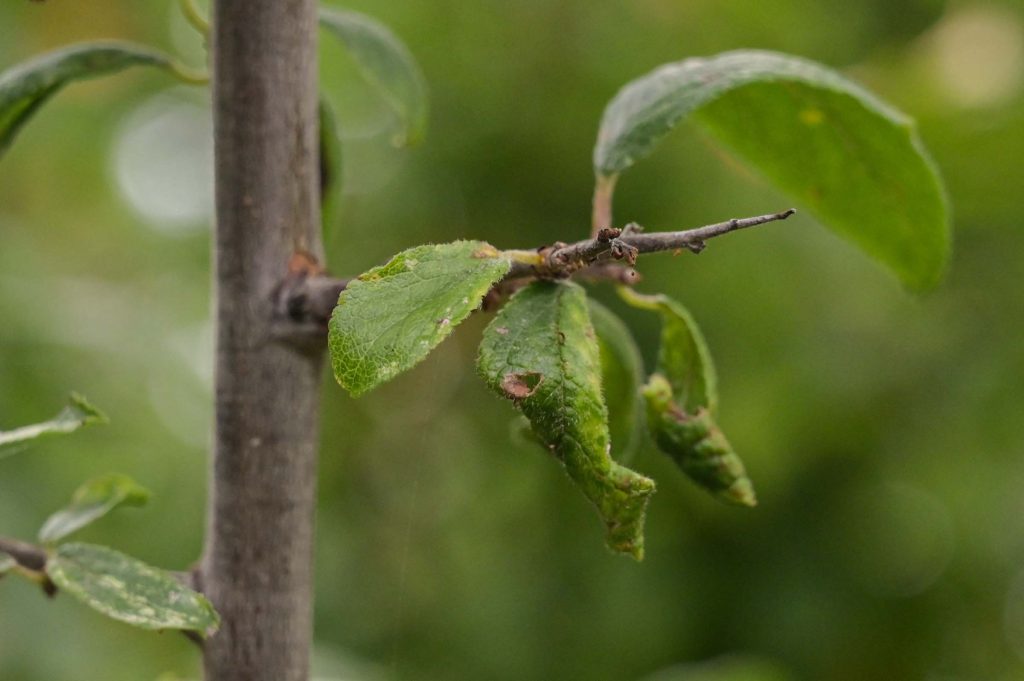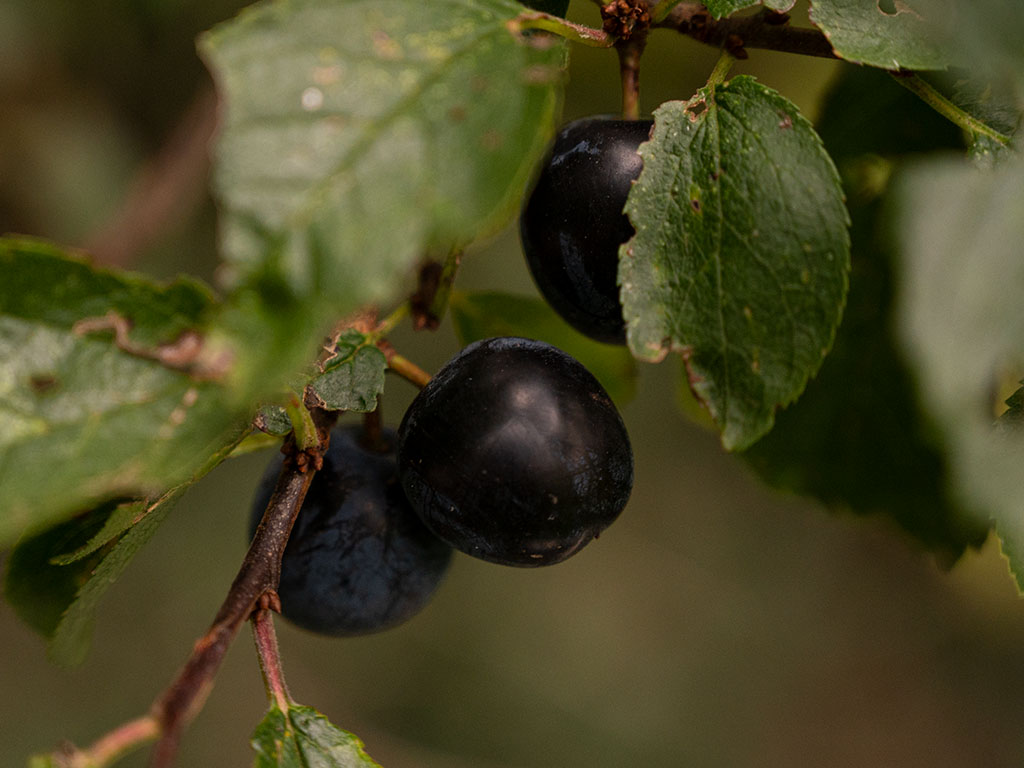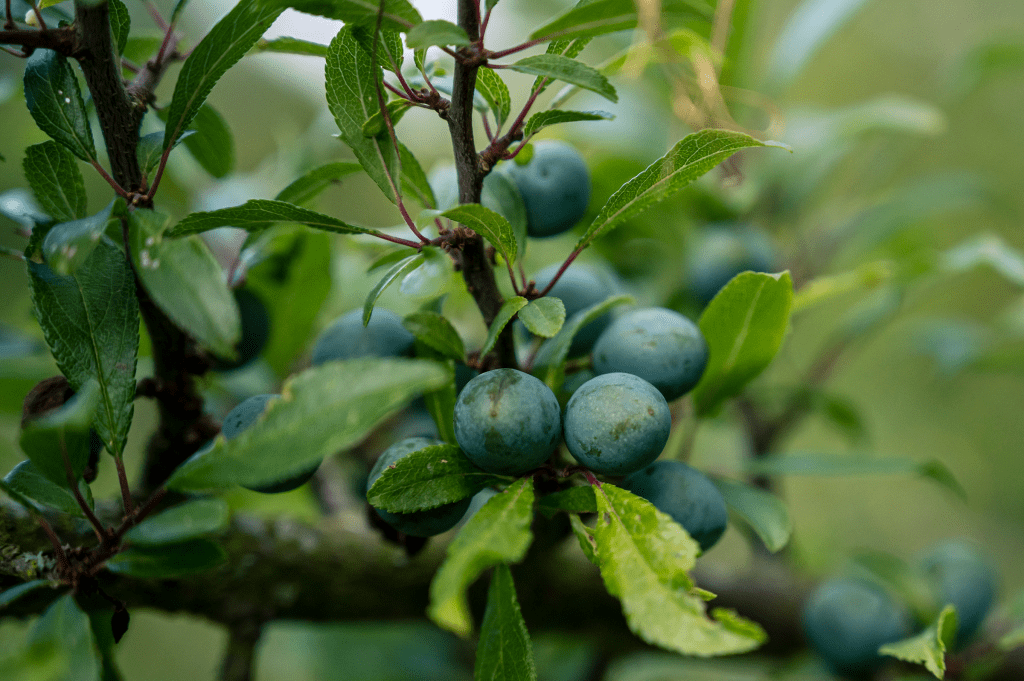What can I do with Hawthorn Berries?
The fruits are easy to identify and collect in large quantities and can be used to make fruit leathers (another name for a fruit roll-up),…

6th September 2023
Blackthorn (Prunus spinosa) is a scrubby, hardy little native plum tree which is one of the first to blossom in spring, almost always in a harsh and cold spell after a ‘false’ spring. This spell of bitter weather is traditionally called a Blackthorn winter and can be counted on to happen, even nowadays with our strange seasons. This shrub has many uses, from wooden walking sticks and traditional Irish shillelaghs to cow-proof hedgerows. Above all else it is now most well-known for it’s fruits which have a complex and rich flavour when used well, combining the taste of berries with plums.
Blackthorn bushes grow throughout the UK and are most commonly found in hedgerows and at the edge of woodland. They are of the type which send out suckers from the roots and so can quickly take over an area and form a spiny thicket which keeps out all but the most intrepid or thick skinned of creatures. These thickets are important breeding areas for some of our smaller birds, who nest in amongst the branches for protection from predators.
The flowers, leaves and fruits of Blackthorn are all edible, however most people consider the fruits, also known as ‘sloes’ to be the most prized contribution. The best time of year to collect sloes is autumn, once they have become dark purple in colour and slightly soft when you squeeze them. Traditionally sloes would be picked after the first frost in October or November, this is partly because the fruits are at their most ripe at this time of year. Alongside this, the freezing and thawing action of the frost splits the skins of the fruits meaning that the juice is easier to extract. Nowadays most people pick sloes once they are ripe (frost or no), put them into bags in the freezer for a couple of days to imitate the frost.
Blackthorn is a member of the plum family (which in turn is part of the Rose family). These trees never grow tall like an Ash or an Oak, but often form scrubby thickets at the edge of woodlands or on unmanaged fields surrounded by hedgerows. In Spring, the identifying feature to look out for is the white flowers on branches bare of leaves, when the leaves do arrive they are simple and resemble those of other plums and also apples. Through summer and into autumn, you will see the fruits developing on the branches, they are a little bit smaller than grapes and hang singly on very short stems, so they look as though they are attached straight onto the branches.
The most definitive feature of all for identifying blackthorn are the thorns. Rather than being small and looking like a rose or bramble thorn, they are long spines with the appearance of a twig that tapers to a sharp and fragile point, they often even have leaves growing on them. Although the tree isn’t toxic, the spines can cause serious injuries, at the end there lives a cocktail of bacteria and if you are scratched or stabbed by this thorn, the wound often gets infected. However, this isn’t usually enough to credit a doctor’s visit and will clear up if kept clean. Our pro-tip for picking sloes, is to always space out if you are working with somebody else, purely so that when you pluck the fruit from the tree, the branch can’t bounce back into their face.
Finally, if you have found fruits which you believe to be sloes on a tree which you are certain of, it is well worth biting into a ripe fruit and sucking some of the juice out. It is an experience that you will never forget as sloes are highly astringent and it will feel as though all of the moisture has been sucked out of your mouth. Thankfully this feature doesn’t make it into the drinks, jams and sauces which you might make from sloes.
There are a few species which can be mistaken for blackthorn, but the worst that will happen is an unexpected flavour. In spring there is often an overlap in blossom with Hawthorn, which looks remarkably similar from a distance, but up close the hawthorn tree will have leaves and the thorns are very different. If you are out scouring the hedgerows for sloes, you may come across a Damson, Bullace or other plum family tree. The fruits can look near identical, but are usually bigger and the trees lack the spines of the blackthorn.
Something to look out for affecting your local Blackthorn trees is Pocket Plum which is a gall induced by a fungus which changes the way that the fruit grows and can result in a very poor harvest.



Foraging and hunting for wild food is a potentially hazardous activity. Whilst we try to make sure these wild food guides are as accurate as possible there is ALWAYS the possibility of misidentifying a plant or other item and the descriptions given might also apply to similar toxic plants. Common names cannot be relied upon as they change from region to region, and there are some similar names for very different plants.
You should always be confident of the identification of a plant, fungus or lichen BEFORE you touch it and especially before you put it anywhere near your mouth. The best way to do that is by checking with a good wild flower key or identification book, and ideally cross-referencing between more than one book. We have a blog post on some of the foraging guide books that we recommend HERE. We also deliver foraging and wild foods training through private bookings and our Academy.
With over a decade of experience working outside in the UK doing everything from dry stone walling to tree planting and carrying out wildlife surveys. Amy is our resident ecologist and wild food enthusiast, and also works as a consultant for various brands and wildlife organisations. Amy lives in North Wales.
A Life More Wild is the philosophy which underpins everything we do.
It encompasses practical skills, personal development, community learning and a journey to live more intentionally.
The fruits are easy to identify and collect in large quantities and can be used to make fruit leathers (another name for a fruit roll-up),…
North Wales is a fantastic place to look for fungi, with a wide range of habitats and ideal climate. If you’ve been out to a…
This mushroom can be used in stocks, dried and ground down into a powder, or cooked into casseroles, stir fry’s and soups. Our favourite use…
Sloes are ripe before the first frosts these days, but you can use a freezer to imitate the affect of a frost and have some…
